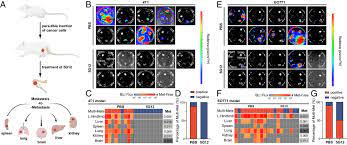Immunotherapy is a very promising method for the treatment of metastatic breast cancer, which can provide new possibilities for treatment. Although checkpoint inhibitors show some hope in the treatment of metastatic breast cancer, their therapeutic effect on patients with bone metastases is disappointing. The lack of such efficacy seems to have a certain specificity for the bone environment, which will show the characteristics of avoiding inhibition. Recently, a research report titled “Siglec-15/sialic acid axis as a central glyco-immune checkpoint in breast cancer bone metastasis” was published in the journal Proceedings of the National Academy of Sciences. Scientists from institutions such as Rice University identified a novel immune pathway that has the potential to treat refractory bone metastases in cancer through their research, cancer bone metastasis is one of the most common forms of cancer metastasis in breast cancer patients.
Researcher Yixian Wang said that more than 70% of patients with metastatic breast cancer will observe cancer cells metastasize to bone, which will lead to bone-related events, such as bone pain, bone and hypercalcemia. Now there are a variety of immunotherapies that are expected to potentially benefit patients with metastatic breast cancer, but they have no therapeutic effect on patients with bone tumors. According to American CDC data, every year there are more than 240000 newly diagnosed breast cancer patients in the United States, and about a quarter of patients will experience cancer metastasis, that is, cancer cells spread from the breast to other parts of the body.
Our Featured Products
| Cat. No. | Product Name | Source | Species | Tag |
| SIGLEC15-256H | Active Recombinant Human SIGLEC15 protein, Fc-tagged | CHO | Human | Fc |
| SIGLEC15-1396H | Recombinant Human SIGLEC15 | Mammalian Cell | Human | His |
| SIGLEC15-01H | Active Recombinant Human SIGLEC15 Protein (ECD), His-tagged | HEK293 | Human | His |
| SIGLEC15-1138H | Recombinant Human SIGLEC15 protein, hFc-tagged | HEK293 | Human | hFc |
| SIGLEC15-10H | Recombinant Human SIGLEC15 protein, His-SUMO-tagged | E. coli | Human | His/SUMO |
| SIGLEC15-5435H | Recombinant Human SIGLEC15 Protein (Met1-Thr263), C-His tagged | Mammalian cells | Human | C-His |
This new type of immunotherapy, known as checkpoint inhibitors, may unveil stubborn tumors and allow the immune system to send out powerful immune cells to deal with abnormal cells. However, although checkpoint inhibitors are effective for many patients, they are not effective for everyone, and clinical trial results have shown that when used to treat patients with bone metastases, patients have almost no response. The researchers hope to find another way that may be more effective in eliminating these stubborn bone metastases. They believe that there must be a new checkpoint axis that can target breast cancer cells in the bone. In addition, the researchers also found a special sugar immune checkpoint axis in bone metastases, which mainly involves a protein called sialic acid binding Ig-like lectin (Siglec) -15. The researchers found that this protein can inhibit the function of immune cells in bone.
When we noticed that Siglec-15 in the tumor microenvironment of bone tumor samples from breast cancer patients was significantly up-regulated, researchers found that this receptor played an important role in hiding bone tumors from immune supervision. At present, FDA-approved checkpoint inhibitors are mediated by protein-protein interactions that can inhibit immune cells. However, Siglec-15 is a sugar immune checkpoint inhibitor that does not bind to proteins, but can bind to sugar molecules on the surface of cells. This may be the reason why it inhibits the function of the body’s immune system, which may be a new type of immune checkpoint. It can provide some hope for the future treatment of bone cancer.

At present, researchers have conducted multiple cell culture experiments to investigate the interaction of Siglec-15 in the bone tumor microenvironment, and they understand that this may be involved in the crosstalk between tumor cells, such as T cells, macrophages, and bone-specific cells (osteoclasts). Researchers say that you can find these glycolipids and glycoproteins in all cells, and they also play important roles in the body’s immune regulation process. Related research findings may provide an opportunity to further investigate these sugar immune checkpoint inhibitors and identify which ones can help bone tumors stop evading the body’s immune recognition process.
To sum up, the results of this study indicate that the increased level of Siglec-15 in bone metastasis habitat may promote tumor-induced osteoclast production and inhibit antigen-specific T cell response, and the antibody blocking of Siglec-15/sialyl sugar immune checkpoint axis may be a potential therapy for breast cancer bone metastasis. Through targeting, researchers can not only treat cancer bone metastasis, it can also inhibit the spread of metastatic cancer cells from the site of bone lesions to other organs.
Related Products and Services
Protein Expression and Purification Services
Reference
Yixian Wang,Zhan Xu,Kuan-Lin Wu, et al. Siglec-15/sialic acid axis as a central glyco-immune checkpoint in breast cancer bone metastasis, Proceedings of the National Academy of Sciences (2024). DOI: 10.1073/pnas.2312929121